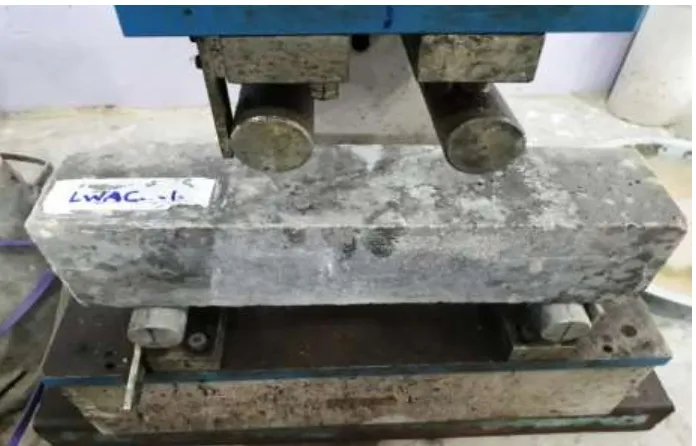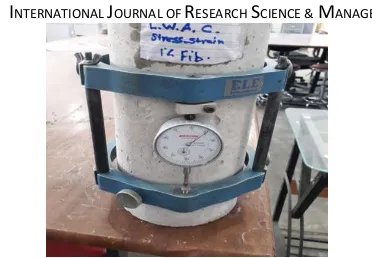[Ghani * et al., 5(4): April, 2018]
ISSN: 2349-5197
Impact Factor: 3.765
I
NTERNATIONAL
J
OURNAL OF
R
ESEARCH
S
CIENCE &
M
ANAGEMENT
STRUCTURAL BEHAVIOR OF NO FINE CONCRETE AND LIGHTWEIGHT
AGGREGATE CONCRETEREINFORCED WITH STEEL FIBERS
Assist. Lect Rasha Abd Al-Redha Ghani*
*Civil Engineering Department, College of Engineering, University of Kufa, Iraq
DOI: 10.5281/zenodo.1215952
Keywords
:
Fiber Reinforced Concrete , Modulus of Elasticity , Tensile Strength ,Flexural strength, Lightweight Concrete..Abstract
Due to low values of mechanical properties of lightweight concrete , lightweight concrete is rarely used in structural members in buildings or structures , the lowest value of compressive strength can be used for concrete is 17 MPa, thus this investigation deals with improving the mechanical properties of two types of lightweight concrete , the first type is lightweight aggregate concrete (LWAC), and the second is no-fines concrete (NFC).The results show that adding steel fibers lead to high increment in flexural and tensile strength in NFC, the flexural strength increased from low value of 1.78 to 6.5MPa(more than 3 times) , the compressive strength also increased but less than the increment in flexural strength . compressive strength increased from 13.6 to 26.1 MPa (doubled) for optimum percentage of steel fiber which was 2.5% and also the study show increment in all mechanical properties in LWAC concrete when adding steel fibers.
Introduction
Lightweight concrete (LWC)mostly used in production of lightweight blocks or bricks and used in partitions of buildings , houses and framed structures , because of its low density that leads to reduce the total weight (dead weight) of building and hence low cost for structure. The use of steel fibers in concrete is very important to increase ductility [ 1 ] and also all mechanical properties , like compressive , tensile , and flexural strength the fiber reinforced concrete applications is very wide , it used in bridges ,precast products, structures in seismic regions, high loaded members and in concrete that needs to prevent cracks [ 2] , using fiber reinforced concrete leads to increase toughness , ductility and durability of concrete [ 3 ].The need to improve the mechanical properties of LWC is important so that it may be used as structural members. This investigation show how can steel fibers take rule to improve two types of lightweight concrete the first is no fine concrete which is concrete without fine aggregate or sand , and the second type is lightweight aggregate concrete which using crushed thermo -stone as lightweight aggregates, the no-fines concrete used in study with density of 1787 kg/m3 , and for LWCA the density was 1550 kg/m3.
Experimental Program
No-Fines Concrete
Using mix proportion of 1: 5 (cement :gravel), the gravel with maximum size aggregate of 16 mm maximum size aggregate according to Indian standards IS-383 [ 4 ],shown in table 1 , ordinary Portland cement used in all mixes.
Table 1 : Sieve Analysis Of Black Gravel In No-Fines Aggregate
IS –Sieve Size , Mm % Passing By Weight ( %) Indian Specification (% Pass)
40 100 100
20 100 100
16 87.3 85 - 100
12.5 - -
10 23.9 0 - 30
4.75 4.2 0 - 5
[Ghani * et al., 5(4): April, 2018]
ISSN: 2349-5197
Impact Factor: 3.765
I
NTERNATIONAL
J
OURNAL OF
R
ESEARCH
S
CIENCE &
M
ANAGEMENT
Lightweight Aggregate Concrete
Using 1: 1.5: 0.875 (cement : fine aggregate: coarse aggregate) by weight in this case to get another type of light weight concrete , the lightweight aggregate obtained by crushing thermo-stone blocks , and the maximum size aggregate is also 16 mm , and shown in table 2.
Table 2 : Sieve Analysis Lightweight Aggregates Made From Thermo-Stone Blocks For Lightweight Aggregate Concrete IS –Sieve Size , Mm % Passing By Weight ( %) Indian Specification (% Pass)
40 100 100
20 100 100
16 85.9 85 - 100
12.5 - -
10 11.2 0 - 30
4.75 0.8 0 - 5
2.36 - -
Table 3 : Sieve Analysis Of Sand (Fine Aggregates) For Lightweight Aggregate Concrete
IS –Sieve Size , Mm Or Mic. % Passing By Weight ( %) Indian Specification (% Pass)
10 100 100
4.75 100 95-100
2.36 95.3 95 - 100
1.18 91.0 90 -100
600 Micron 83.8 80 - 100
300 Micron 44.2 15-50
150 Micron 3.7 0 -15
Steel Fibers
The steel fibers that used in this study is from type Micro-steel fiber show in figure 1, which have very high tensile strength and coated with brass to prevent corrosion , table 4 shows properties of micro steel fibers used in study.
[Ghani * et al., 5(4): April, 2018]
ISSN: 2349-5197
Impact Factor: 3.765
I
NTERNATIONAL
J
OURNAL OF
R
ESEARCH
S
CIENCE &
M
ANAGEMENT
Table 4 : Steel Fibers Specifications Used In The Study Type And
Manufacture
Length Diameter Aspect Ratio Tensile
Strength Micro steel fiber
,coated with brass , China
13 mm 0.2 mm 65 2850 MPa
Specimens and Tests
Molds used in study were cubic moulds for compressive strength with (15*15*15 )cm , cylindrical moulds of (10*20) cm used for tensile strength test , and cylindrical molds with (15 *30) cm for calculating the modulus of elasticity . the tensile strength done by using splitting test of cylinder , and Ft value was found by equation 1.
Ft = 2P / π DL ---(1) Where :
Ft : is the tensile strength of concrete specimen P : Is the maximum force applied
D : diameter of cylinder and L : Is the height of cylinder
For flexural strength , beams with (100*100*400) mm were used , then finding the average flexural strength of three specimens for each mix by equation 2
F b= PL/ bd2 ---(2)
Where :
Fb : is the flexural strength P : max. load
L : Length of beam b : is the width of beam d : is the depth of beam
[Ghani * et al., 5(4): April, 2018]
ISSN: 2349-5197
Impact Factor: 3.765
I
NTERNATIONAL
J
OURNAL OF
R
ESEARCH
S
CIENCE &
M
ANAGEMENT
Fig.3 : Lightweight Aggregate Concrete Cylinder Before Testing To Stress-Strain Diagram.
Results and Discussion
For No-Fines Concrete
[Ghani * et al., 5(4): April, 2018]
ISSN: 2349-5197
Impact Factor: 3.765
I
NTERNATIONAL
J
OURNAL OF
R
ESEARCH
S
CIENCE &
M
ANAGEMENT
Table 5 : Mechanical Properties Of No-Fines Lightweight Concrete (NFC)
Concrete Type Compressive
Strength(Mpa)
Tensile Strength(Mpa)
Flexural Strength(Mpa)
Modulus Of Elasticity(Mpa)
NFC(1:5)Cement: Coarse Aggregate
13.65 1.50 1.78 11223
NFC with o.1 % steel fiber
14.05 1.83 2.01 11877
NFC with 0.5 % steel fiber
16.80 2.98 3.84 13400
NFC with 1 % steel fiber
18.86 3.66 4.42 15907
NFC with 1.5% steel fiber
22.27 3.90 4.75 19822
NFC with 2% steel fiber
24.61 4.61 5.37 21285
NFC with 2.5% steel fiber
26.11 4.90 6.33 22445
[Ghani * et al., 5(4): April, 2018]
ISSN: 2349-5197
Impact Factor: 3.765
I
NTERNATIONAL
J
OURNAL OF
R
ESEARCH
S
CIENCE &
M
ANAGEMENT
Fig. 6 Flexural Strength Test Fig. 7 Modulus Of Elasticity Test
Figures (4-7) The Mechanical Properties of (NFC) modified with steel fibers
For Lightweight Aggregate Concrete
Mechanical properties of Lightweight Aggregate concretetheir results appear as follows:Compressive strength increased from 11.4 MPa to 22.7 MPa , tensile strength increased from 1.3 to 2.59 MPa , and flexural strength increased from 1.8 to 5.2 MPa , and that were very good increments , also modulus of elasticity improved from 9800 MPa to20500 MPa , and that is an excellent improvement , figures(8- 11) show the improvement in compressive strength, tensile strength , flexural strength and modulus of elasticity for LWAC and table (6) shows the mechanical properties of Lightweight Aggregate concrete.
Table 6: Mechanical Properties Of Lightweight Aggregate Concrete (LWAC)
Concrete Type Compressive Strength(Mpa) Tensile Strength(Mpa) Flexural
Strength(Mpa)
Modulus Of
Elasticity(Mpa)
LWAC 11.45 1.33 1.83 9810
LWAC , with micro steel fibers , 0.1%
12.85 1.56 1.90 9945
LWAC , with micro steel fibers , 0.5%
15.20 1.70 2.65 11227
LWAC , with micro steel fibers , 1%
17.86 1.88 3.87 15298
LWAC , with micro steel fibers 1.5%
20.89 2.16 4.01 17443
LWAC , with micro steel fibers 2%
22.70 2.55 4.78 19607
LWAC , with micro steel fibers , 2.5%
[Ghani * et al., 5(4): April, 2018]
ISSN: 2349-5197
Impact Factor: 3.765
I
NTERNATIONAL
J
OURNAL OF
R
ESEARCH
S
CIENCE &
M
ANAGEMENT
Fig. 8Compressive Strength Test Fig. 9Tensile Strength Test
Fig. 10 Flexural Strength Test Fig. 11 Modulus Of Elasticity Test
[Ghani * et al., 5(4): April, 2018]
ISSN: 2349-5197
Impact Factor: 3.765
I
NTERNATIONAL
J
OURNAL OF
R
ESEARCH
S
CIENCE &
M
ANAGEMENT
Conclusions
Mechanical properties of lightweight concrete both two types ( lightweight aggregate concrete and no-fines concrete ) can improved by using steel fibers . the following items achieved in this research :
1- Compressive strength increased in (LWAC) by adding steel fibers until 2% fibers , the increment was about 98% then the increment after that (until 2.5% ) was very small.
2- Flexural strength was highly increased with adding steel fibers , the increment in flexural strength was 184% and this is perfect .
3- Modulus of elasticity also increased highly from 9800 to 20500 MPa , and this increment attributed by behavior of fiber specimens that shows less strain values under loading .
4- The mechanical properties for no-fines concrete also increased by adding steel fibers , compressive strength increased from 13.6 to 26.1 MPa , the tensile strength increment was about 226 % , flexural strength increment was high also and it was about 255% , and modulus of elasticity increment was about 200%(doubled).
References
[1] Balaguru,P. and Foden,A ,” Properties of Fiber Reinforced Structural Lightweight Concrete”,ACI Structural Journal , Technical Paper, title no.93, 1996 ,p.p 61-78.
[2] Someh , A. , and Saeki ,N. , “prediction for the stress-strain curve of steel fibers reinforced concrete “,transaction of the japan concrete institute , vol-18 , 1996 , p.p-175-182.
[3] Musmar, M. ,”tensile strength of steel fiber reinforced concrete”, contemporary engineering sciences , vol 6 , no. 5 ,2013 , p.p -225-237.
[4] IS- 383 ,”Indian standards Specifications for Coarse and Fine Aggregates”, ninth edition , September 1993.
[5] Taengua, E. ,and Marti ,E. , “ Bond of reinforcing bars of steel fiber reinforced concrete” ,university of leeds , white rose research online, http://eprints.whiterose.ac.uk/92883 ,construction and building materials, ISSN, 0950- 0618 , 2016 ,p.p 1-28.
[6] Gao, J ,and Morino,K.”Mechanical properties of Steel Fiber –Reinforced High Strength, Lightweight Concrete”, ELSEVER, Cement and Concrete Composites “, Vol 19 , Issue 4 ,1997 ,p.p 307-313. [7] Thomas , J. , and Ramas , A., “Mechanical properties of steel fiber reinforced concrete “ ,journal of
materials in civil engineering” , May , 2007 , p.p 385 – 392.
[8] Shehab, H. and Khater , M. ,”Mechanical Properties of Ultra High Performance Fiber Reinforced Concrete “, International Journal of Engineering and Innovative Technology( IJEIT) ,Vol 4 , Issue 4, October , 2014, p.p 4-10






